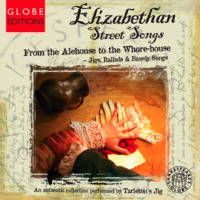
Get Up and Dance
Elizabethan
street songs -
heard by
MARIA NOCKIN'... plain good listening ...'
|

|
Globe Editions of The Shakespeare Globe Trust has published a new sixty-three minute CD (GE 002) called:
Elizabethan Street Songs
From the Alehouse to the Whore-house
-- Jigs, Ballads and Bawdy Songs
This interesting disc contains authentic instrumental and vocal music from the late sixteenth and early seventeenth centuries sung and played by Tarleton's Jig. Most of the selections were originally popular tunes familiar to the common people of London and its environs. Recorded by Glenn Keiles at the Garden House Studio, the disc's sound is clear and has the feeling of intimacy proper for this kind of early music.
The band, which was founded in 1978, is named after Dick Tarleton, a comic of Shakespeare's time. Jim Bisgood, Keith Thompson, Sharon Lindo and Keith McGowan are the members of the group. The booklet that comes with the CD informs the listener what instruments each of them plays, but not which ones are played during each piece. The band's stringed, wind and percussion instruments are authentic copies of those used at the time the selections were popular and the booklet supplies considerable information about them.
Each of the band members demonstrates superior musicianship and there is no fault to be found with their tonal accuracy or stylistic interpretation. Jim Bisgood and Sharon Lindo also do the lead vocals, however, and it is immediately apparent that they are not really singers. It might be good to hear some of this music sung by trained voices, but in all probability this type of music is more authentically performed by amateurs.
Kemp's Jeg honors Shakespearean comic, William Kemp, who is said to have danced all the way from London to Norwich in nine days. They were not nine consecutive days, however, and he took refuge in many a tavern along the way. Stanes' Morris is a good example of a charming Morris dance. Its lilt is a universal invitation to dance. No wonder it was denounced as pagan and hated by the Puritans.
Listen -- Stanes' Morris
(track 2, 0:23-1:09) © 2008 The Shakespeare Globe Trust
Once popular tunes like Bara Faustus' Dream and the Half Hannikin were published in William Ballet's late sixteenth century lute books. The Dream may once have had verses while the Half Hannikin is a dance still in use by medieval and Renaissance groups. The Baffled Knight, The Three Ravens and We Be Soldiers Three are early seventeenth century compositions by Thomas Ravenscroft. Packington's Pound, a slow courtly dance published by Francis Cutting in 1596, eventually became a popular lute tune. Here, it is followed by the toe tapping Bransle de Bretaigne arranged by Gervaise and Adrian LeRoy a few decades earlier.
Listen -- Packington's Pound
(track 5, 0:00-0:27) © 2008 The Shakespeare Globe Trust
Cuckolds All in a Row is one of several songs in which the lady has won the battle of the sexes. That theme, also heard in The Baffled Knight and Give Me My Yellow Hose Again, could elicit a great deal of laughter in the theater. Bobbing Joan, the ribald lyrics of which are not heard here, and the wonderfully tuneful Parson's Farewell were found in John Playford's mid-seventeenth century book, The English Dancing Master.
Listen -- Parson's Farewell
(track 16, 0:00-0:54) © 2008 The Shakespeare Globe Trust
Goddesses, with which Bobbing Joan is here combined, was published for keyboard by Giles Farnaby in his Fitzwilliam Virginal Book of 1590. It is followed by a medley that combines a Scottish tune with two English ditties played by the smooth, almost legato sound of the Flemish bagpipes.
All in a Misty Morning, also known as The Friar and the Nun, is a song from the late sixteenth century with a rough, lean sound. Well known composer, William Byrd, arranged the memorable ballad called The Carman's Whistle. Like many of these songs, it comes with various verses, some more acceptable to a general audience than others. Give Me My Yellow Hose Again is another raucous late sixteenth century tavern song. This version indicates the end of an unhappy marriage.
The Horse's Bransle and The Frog Galliard were originally court dances. The Frog may refer to a French duke who wished to marry Elizabeth I. Like much court music, these dances eventually worked their way down to the common people. The Owl is a rousing early seventeenth century drinking song that finishes off this rollicking opus with a flourish. It explains why so many famous old taverns are named after that bird.
This CD is not only a glimpse into the times of Henry VIII and Elizabeth I, it is just plain good listening and might even move the listener to get up and dance.
Listen -- Never Let Crueltie
(track 11, 0:30-1:38) © 2008 The Shakespeare Globe Trust
Copyright © 29 December 2008
Maria Nockin, Arizona USA
 BUY CLASSICAL CDS ONLINE
CD INFORMATION: ELIZABETHAN STREET SONGS
BUY CLASSICAL CDS ONLINE
CD INFORMATION: ELIZABETHAN STREET SONGS
| 
